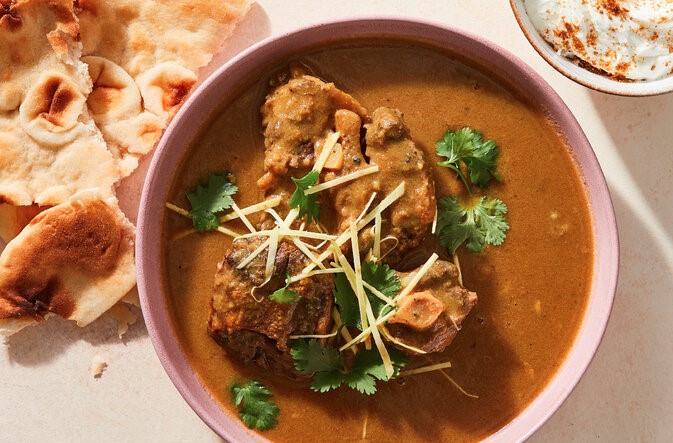Introduction: Indian Stew, A Flavorful Delight
One of the most popular and delicious dishes in Indian cuisine is the stew, known for its rich and robust flavors. Indian stews are a unique blend of spices, herbs, and vegetables or meats, slow-cooked to create a deep and complex flavor profile. These hearty and filling stews are perfect for a comforting meal on a chilly evening or a special occasion feast.
Indian stews are a reflection of the country’s diverse regional cuisines and cultural influences, making them a fascinating and delightful culinary experience. From the North to the South, East to West, Indian stews offer a range of flavors, textures, and aromas that tantalize the taste buds and satisfy the soul.
The History of Indian Stew
The history of Indian stews can be traced back to ancient times when people used slow-cooking methods to make nourishing and flavorful meals. Over time, the stews evolved to incorporate various spices and ingredients from different regions, resulting in a diverse range of stews with distinct flavor profiles.
The Mughals, who ruled India from the 16th to the 19th century, introduced new cooking techniques and spices, such as saffron, cardamom, and turmeric, which greatly influenced Indian cuisine. The British colonial rule in the 18th and 19th centuries also left its mark on Indian stews, with the introduction of meat-based stews and the use of potatoes and tomatoes as thickening agents.
Today, Indian stews continue to evolve, with modern chefs experimenting with new techniques and ingredients while staying true to the traditional flavors and cooking methods.
The Essentials: Spices and Cooking Techniques
The key to making a delicious Indian stew is the use of the right spices and cooking techniques. Indian cuisine is known for its complex spice blends, which are used to add flavor, aroma, and color to the stews.
Some of the essential spices used in Indian stews include cumin, coriander, turmeric, cinnamon, cloves, cardamom, and chili powder. These spices are often used in combination with each other to create unique flavor profiles.
Indian stews are typically slow-cooked for several hours, allowing the flavors to meld and develop into a rich and complex taste. Some stews may also be cooked in a pressure cooker to save time and retain the nutrients of the ingredients.
Vegetarian or Non-vegetarian: The Choice is Yours
Indian stews are versatile and can be made with a variety of ingredients, including vegetables, meat, and seafood. Vegetarian stews are popular in India, with recipes such as chana masala, dal makhani, and vegetable korma being widely enjoyed.
Non-vegetarian stews, such as chicken tikka masala, lamb korma, and beef curry, are also popular and offer a range of flavors and textures.
The Top Five Traditional Indian Stews
- Butter Chicken: A creamy and flavorful chicken stew made with a tomato-based sauce and a blend of aromatic spices.
- Rogan Josh: A lamb stew from the Kashmiri cuisine, known for its rich and spicy flavor.
- Chana Masala: A vegetarian stew made with chickpeas, tomatoes, and a blend of spices, commonly served with rice or bread.
- Hyderabadi Biryani: A meat-based stew made with rice, spices, and marinated meat, cooked in a dum-style.
- Dal Makhani: A vegetarian stew made with black lentils, butter, cream, and a blend of spices, commonly served with rice or naan.
Regional Variations: A Culinary Tour of India
Indian stews vary greatly across regions, with each region offering its unique twist on the dish. For example, the stews from North India tend to be rich and creamy, while those from South India are spicier and tangier.
Some of the regional variations of Indian stews include Kashmiri Rogan Josh, Andhra Chicken Curry, Kerala Fish Stew, and Punjabi Chole.
Beyond Meat: Seafood and Lentil Stews
While meat-based stews are popular, Indian cuisine also offers a range of delicious seafood and lentil stews. Fish curries, such as Goan Fish Curry and Bengali Fish Stew, are flavorful and aromatic, while lentil stews, such as Sambar and Rasam, are nourishing and delicious.
How to Pair Indian Stews with Rice or Bread
Indian stews are best served with a side of rice or bread, such as naan, roti, or paratha. This helps soak up the flavorful sauce and adds a satisfying texture to the meal. Basmati rice is commonly used in Indian cuisine, but other varieties such as brown rice or quinoa can also be used.
Tips for Making the Perfect Indian Stew
- Use fresh and quality ingredients, especially spices.
- Allow the stew to simmer for several hours to develop the flavors.
- Adjust the spice levels to your taste.
- Serve the stew with a side of rice or bread.
- Practice and experiment with different spices and ingredients to create unique flavor profiles.
Conclusion: Savor the Flavors of India
Indian stews are a celebration of the country’s rich and diverse culinary heritage. Whether you prefer vegetarian or non-vegetarian stews, there is a flavor profile for everyone to enjoy. With the right spices and cooking techniques, you can create a delicious and nourishing Indian stew that will satisfy your taste buds and warm your soul.



